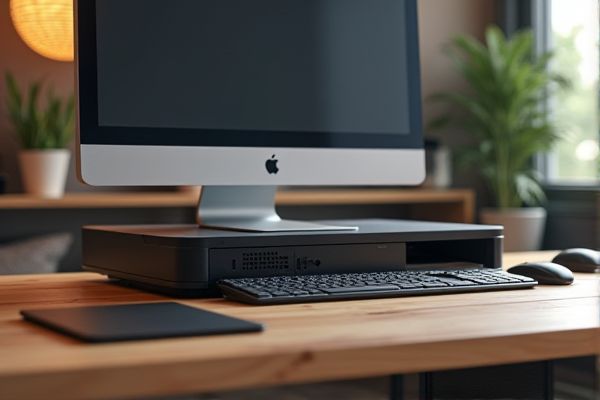
A CPU holder is a mounting accessory designed to securely attach your computer's CPU case underneath or beside a desk, optimizing space and preventing damage, whereas a CPU tray typically refers to a sliding platform installed under the desk for easier access and mobility of the CPU. Discover the best option for Your workspace by reading further to understand the pros and cons of each.
Table of Comparison
| Feature | CPU Holder | CPU Tray |
|---|---|---|
| Installation | Mounted under desk, usually with adjustable brackets. | Placed on desk or shelf, often fixed or sliding. |
| Mobility | Allows easy movement of CPU with swivel or wheels. | Generally fixed; limited mobility. |
| Space Saving | Optimizes desk space by lifting CPU off floor. | Occupies desk surface or shelf area. |
| Protection | Keeps CPU safe from dust and accidental kicks. | Less protection; exposes CPU to potential damage. |
| Price Range | Moderate to high, depending on features. | Generally lower cost. |
| Best Use | Ideal for ergonomic setups and clean desk designs. | Suitable for simple, stationary CPU placement. |
Introduction to CPU Holders and CPU Trays
CPU holders and CPU trays serve as essential accessories for organizing and securing your computer's central processing unit. CPU holders typically clamp or mount the CPU tower under or beside the desk to save space and improve airflow, while CPU trays provide a stable platform that can slide in and out for easy access and maintenance. Choosing the right option depends on your workspace layout and cooling preferences to enhance your computer setup's efficiency.
What is a CPU Holder?
A CPU holder is a specialized mount designed to securely support a computer's central processing unit (CPU) tower, typically positioned under or beside a desk to save space and improve airflow. Unlike a CPU tray that simply slides or rests on the desk surface, a CPU holder often features adjustable brackets, wheels, or straps for enhanced stability and mobility. This accessory helps prevent dust accumulation and physical damage by elevating the CPU off the floor and reducing contact with surfaces.
What is a CPU Tray?
A CPU tray is a mounting platform designed to securely hold a computer's central processing unit (CPU) tower under a desk or workstation, providing easy access while saving desktop space. It typically features adjustable brackets or sliding rails to accommodate various CPU sizes and models. Unlike a stationary CPU holder, the tray often includes wheels or a sliding mechanism for enhanced mobility and convenience during hardware maintenance.
Key Differences Between CPU Holders and CPU Trays
CPU holders are designed to securely mount your computer tower, often featuring adjustable straps or clamps for added stability, while CPU trays typically provide a flat, sliding platform that fits under or beside your desk. Holders excel in preventing movement and protecting the CPU from dust and accidental knocks, whereas trays prioritize ease of access and mobility with wheels or sliders for convenient positioning. Choosing between a holder or tray depends on your need for either enhanced security and protection or flexible, ergonomic access to your device.
Benefits of Using a CPU Holder
A CPU holder offers enhanced ergonomic benefits by allowing adjustable placement of the CPU, reducing the risk of strain or injury during access and maintenance. It also improves workspace organization by freeing up floor space and protecting the CPU from dust and accidental damage. Compared to a fixed CPU tray, holders provide greater flexibility for cleaning and cable management, promoting a safer and more efficient computing environment.
Advantages of Using a CPU Tray
A CPU tray offers enhanced flexibility by allowing easy access and movement of your computer's central processing unit, making maintenance and upgrades more convenient compared to a fixed CPU holder. It helps save desk space and promotes better airflow, which can improve your CPU's cooling efficiency. Using a CPU tray also reduces wear on cables and ports by minimizing stress during repositioning.
Ergonomics and Workspace Optimization
A CPU holder elevates the computer tower off the floor, promoting better airflow and reducing dust accumulation while keeping the CPU within easy reach, which enhances ergonomics by minimizing the need to bend or stretch. A CPU tray, typically mounted under the desk, saves desk space by tucking the CPU out of sight but may require awkward movements to access power buttons and ports, potentially compromising user comfort. Both options optimize workspace by decluttering floors and desktops, though CPU holders better balance accessibility and ergonomic posture in modern office setups.
Durability and Protection Comparison
CPU holders typically provide enhanced durability with robust metal or heavy-duty plastic construction designed to secure the CPU firmly, reducing the risk of damage from accidental drops or impacts. CPU trays, often made from lighter materials like plastic or thin metal, offer moderate protection primarily against dust and minor bumps but may lack the structural strength to prevent damage during significant shocks. For long-term durability and maximum protection, CPU holders are generally preferred over CPU trays.
Installation and Compatibility Factors
CPU holders offer straightforward installation with adjustable straps or brackets, ensuring secure attachment to various desk types and dimensions. CPU trays typically require mounting underneath the desk surface, which demands precise measurements and compatibility with desk thickness and material. Compatibility factors for CPU holders emphasize portability and desk edge fit, while trays prioritize stability and fixed positioning.
Which Should You Choose: CPU Holder or CPU Tray?
A CPU holder offers adjustable height and mobility, making it ideal for flexible workspace layouts and ease of access during maintenance. In contrast, a CPU tray is typically fixed under the desk, providing a stable and space-saving solution suited for permanent setups. Choosing between a CPU holder and a CPU tray depends on your desk configuration, need for adjustability, and how much space you want to free up.
 homyna.com
homyna.com